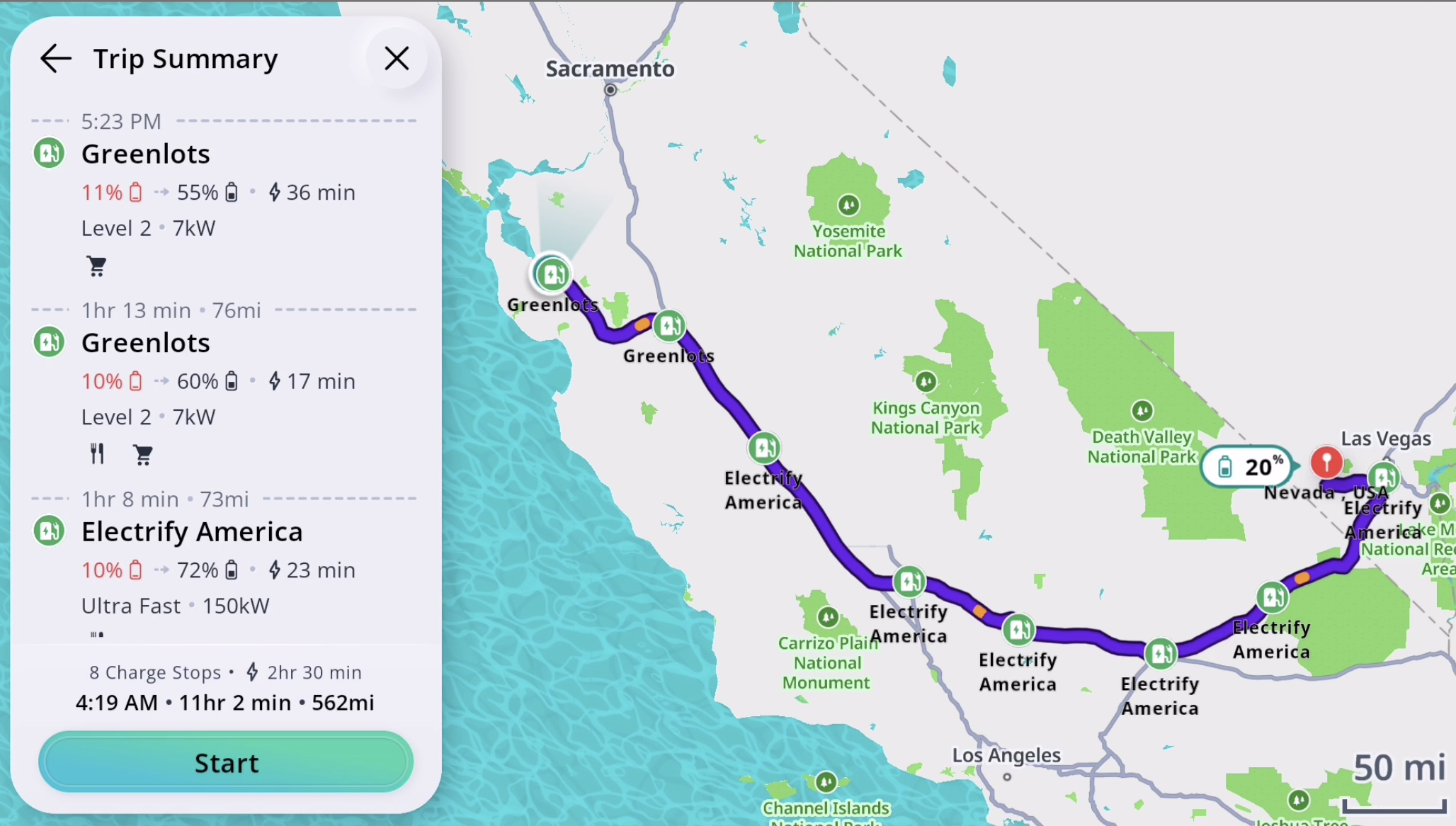EV Navigation
Introduction to TASDK's Electric Vehicle (EV) Features
Electric Vehicle (EV) navigation enhances the driving experience by integrating route planning, driving, and energy management features specifically for electric vehicles. TASDK’s EV functionality is designed to address key factors such as battery charge, charging station locations, and energy efficiency, ensuring drivers can travel long distances without running into issues. This document outlines the core principles, algorithms, and considerations behind effective EV route planning to provide a seamless driving experience.
Features
As a leading provider of advanced navigation SDKs, our EV navigation solution offers two standout capabilities: Automatic Charging Station Planning and Dynamic Route Adjustment Based on Battery Levels. Together, these features ensure a smooth and worry-free driving experience, helping drivers travel efficiently and confidently.
1.Auto Planning of Charging Stations
For EV drivers, access to reliable charging stations is essential. Our SDK automatically plans and integrates charging station stops into the navigation route, removing the guesswork and simplifying the journey.
- Smart Charging Station Detection: The system scans for available charging stations along the route in real-time, factoring in the type of charger (fast, standard) and network compatibility to ensure a smooth charging experience. Furthermore, each EV model’s specific attributes are incorporated into the AI training process, allowing for highly accurate energy usage predictions under various driving conditions.
- Optimized Charging Stops: Based on the vehicle’s battery level and destination, the SDK dynamically suggests the most strategic charging stations, helping drivers avoid range anxiety and saving time by minimizing detours.
- Real-Time Updates: The navigation system continuously updates with the latest data on charging station availability, ensuring drivers always have access to the nearest or most convenient charging options, even in changing traffic conditions or network disruptions. This auto-planning feature ensures that EV drivers never have to worry about finding the right place to charge during their trip, giving them confidence in their route planning.
This auto-planning feature ensures that EV drivers never have to worry about finding the right place to charge during their trip, giving them confidence in their route planning.
2. Dynamic Route Adjustment Based on Battery Status
Our SDK’s ability to dynamically adjust the route based on battery status takes energy management to the next level. As the vehicle's battery level drops during the journey, the system continuously monitors and recalculates the optimal route.
- Real-Time Battery Monitoring: The SDK tracks the current charge level, vehicle efficiency, and real-time road conditions to determine if the current route is feasible without running low on battery.
- Automatic Rerouting: If the battery is low or the vehicle's energy usage is higher than expected (due to road terrain, weather, or driving speed), the system will automatically re-route to a closer charging station or an energy-efficient path, ensuring the driver never runs out of power unexpectedly.
- Route Flexibility: The system takes into account the nearest charging stations, the vehicle’s range, and overall driving conditions to ensure that drivers can still reach their destination safely—even if they need to adjust their course. By dynamically adjusting the route, this feature offers a real-time response to battery levels, providing drivers with peace of mind that their journey is always optimized, even when unexpected changes occur.
By dynamically adjusting the route, this feature offers a real-time response to battery levels, providing drivers with peace of mind that their journey is always optimized, even when unexpected changes occur.
Why These Features Matter:
Both auto planning of charging stations and dynamic route adjustment are critical for ensuring a smooth EV experience. Together, they tackle two of the most common pain points for electric vehicle drivers: finding charging infrastructure and managing battery range on long trips. These features help you:
- Eliminate Range Anxiety: Drivers can confidently rely on the navigation system to guide them to the nearest charging station and adjust the route in real-time to preserve battery life.
- Improve User Satisfaction: By offering dynamic, intelligent route planning that accounts for real-time battery status, you’re providing a premium, hassle-free experience that users will love.
- Enhance Efficiency: These features optimize both route planning and energy consumption, helping EV drivers save time and reduce the environmental impact of their journey.
By integrating these capabilities into your application, you’re not just offering navigation—you’re providing a smarter, more sustainable way for drivers to travel.
Getting Started
Key Component:ChargingPlanPreference
ChargingPlanPreference is a data class that defines user preferences for route calculation.
Properties:
enableChargingPlanning: Set enable automatically charging station planning.planningStrategy: Set the general strategy to make the plan.preferredConnectorTypes: Set the types of connector preferred to be used for charging.preferredChargerBrands: Set the charger brands preferred to be used for charging.preferredArrivalBatteryLevel: Set the percentage of battery capacity preferred when arriving at final destination.preferToChargeUponArrival: Set whether user would like to charge at destination.preferredStartChargingBatteryLevel: Set the percentage of battery capacity preferred to start charging at charging stations.preferredStopChargingBatteryLevel:Set the percentage of battery capacity preferred to stop charging at charging stations.chargingStationBlocklist: Set the list of charging stations that should not be used in the plan.
Example Usage:
EV route Sample Implementation
Here’s a simple example of setting up the EV route and displaying charging stations:
